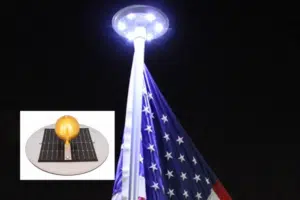
The Benefits of Solar Flagpole Lights
Welcome to the Flagpole Farm blog, where we shed light on all things flag pole related! In today’s post, we’re diving into the radiant world

Flags are everywhere. They come in all shapes and sizes. When you’re determining what flagpole height will be perfect for our house there are a few other questions you’ll have to answer. One of the most common questions when purchasing a flagpole is what size the flag should be.
The answer to this question depends on a few different variables. When choosing a flag you’ll also need to consider your flagpole height.
A variety of possibilities are available when purchasing a flag. We’re going to cover everything you need to know about flagpole height and flag size. Once you’ve gathered all this information you’ll have everything you need to make a purchase.
Let’s learn how exactly a flag and flagpole coincide and the process of everything in between.
Get your questions out of the way first. One of the most popular questions is what size of flag to purchase.
Visualizing the size of a flag can be tricky. A tape measure can handle particulars, but if you’re looking for a more visual way, try your wingspan. The average measurement of your arms spread apart should be around 5 to 6 feet.
The distance from the midpoint of your chest should also help. This will be half of the measurement before at 2 to 3 feet.
You’ll see 3 x 5 flags everywhere. They’re the most common US flag size and usually mounted on most flagpoles. So for visualization purposes, the 3 X 5 flags are half a wingspan high and a full wingspan long.
Let’s continue picturing flagpoles with a 3 x 5 flag in mind.
Telescoping in-ground poles 15 feet or taller will support this size flag. However, sometimes upgrading to a larger flag is the best option. Making sure you have a large enough flag compared to your flagpole will ensure maximum curb appeal.
Most home-mounted poles look good with a 3 X 5 flag as well. A heavy-duty wall-mounted flagpole looks great and can last a long time.
The taller the flagpole, the larger the flag needs to be. There’s an easy math equation that helps with above-ground height. Take the above-ground height and multiply it by 20 percent. You’ll come to an answer determining the size of the width of the flag.
Understanding this number will give you an estimate of flag size you should fly.
Flags and flagpoles are made out of all kinds of materials. Nylon, 2-ply polyester, and cotton are the most common flag materials.
Due to its price point, longevity, and versatility, nylon is the most popular of flag materials. It’s suitable for a range of uses. Nylon handles rain well, is lighter in weight, holds its color well, and dries fast.
Polyester flags provide better durability and strength. The quality of this flag makes it ideal for high winds and daily flying. The 2-ply threading helps improve the strength of the flag to ensure a solid design all around.
Cotton flags were the traditional choice for decades. They’re mostly used nowadays for soft appearance, ease of flow, and value.
Generally speaking, a flag’s lifespan is impossible to predict. Too many factors including wind, weather, and sunlight make up a flag’s life. Quality comes to light when a flag starts experiencing weathering. To help avoid this issue, consider washing, letting dry, and repairing your flag when the time comes.
But what good is a flag without a beautiful flagpole?
All flags and flagpoles are not the same. There are a few factors you’ll need to consider before buying either.
Think about your location. Areas with mountains, desert plains, or coastal weathering need a flagpole that can take the punishment of the wind. Strong gusts are predominantly worrisome in these areas of the world.
It’s common knowledge that sturdier flagpoles are needed for higher winds. The opposite can be said for places with little wind.
Residential and telescoping flagpoles are great for areas like this. Depending on their height, these flagpoles can support a flag up to 5 by 8 feet. Thanks to a reinforced design, these types of flagpoles can support more than you realize. It’s recommended that anyone worried about pole safety should fly a smaller flag, especially in windier areas. Telescoping flagpoles can retract or extend in seconds. Our interlocking sleeve mechanism will extend or retract the pole and provide joint stability to block these uncontrollable events.
And there you have it. Now that you know the ins and outs of flagpole height and flag size you’re off to the races.
Flagpole Farm has been manufacturing Titan’s strong products for years. Based out of Meridian, Idaho, we have been a staple in the residential flag and flagpole industry.
We’re focused on providing you with the best of our Titan flagpoles for sale. Our team is on standby for your needs.
Our 15’ and 20’LT (light duty) flagpoles come with a 3’x5’ Nylon US Flag. Our 20’ and 25’ flagpoles come standard with a 4’x6’ Nylon US Flag. However, you can always upgrade to a polyester flag, and in most cases, you can upgrade the size of your flag too. Check it out here!

Welcome to the Flagpole Farm blog, where we shed light on all things flag pole related! In today’s post, we’re diving into the radiant world

At Flagpole Farm, we understand that the flag isn’t just a piece of cloth; it’s a symbol of freedom, unity, and the unwavering spirit of